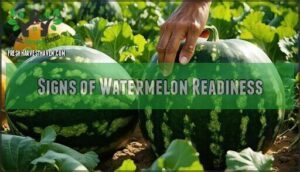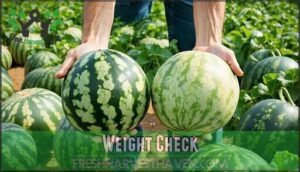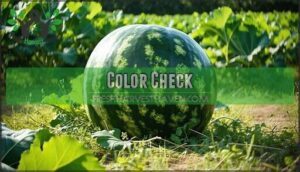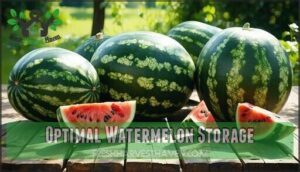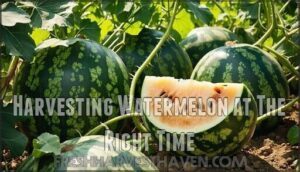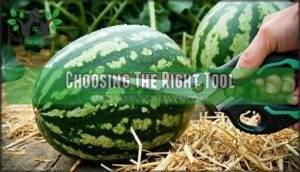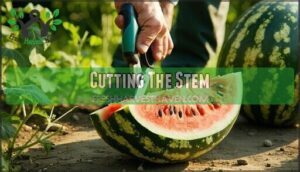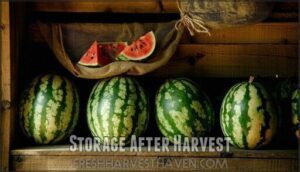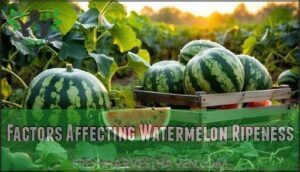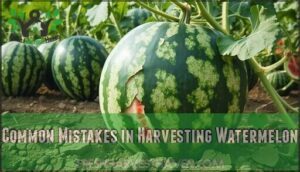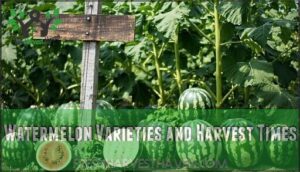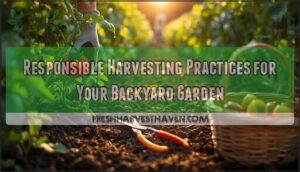This site is supported by our readers. We may earn a commission, at no cost to you, if you purchase through links.
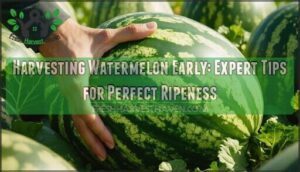
Unlike tomatoes or bananas, watermelons develop their sweetness only while attached to the vine. The final two weeks are vital for sugar development.
Instead of rushing, look for key ripeness signs: a creamy yellow ground spot where it rested, brown tendrils near the stem, and a dull (not shiny) rind.
The watermelon should sound hollow when thumped and feel heavy for its size. Perfect timing transforms a bland melon into summer’s sweetest reward, and knowing exactly when requires mastering several foolproof techniques.
Table Of Contents
- Key Takeaways
- Why Harvest Watermelon Early
- Signs of Watermelon Readiness
- How to Check for Ripeness
- Consequences of Late Harvest
- Optimal Watermelon Storage
- Harvesting Watermelon at The Right Time
- Tips for Picking Watermelon
- Factors Affecting Watermelon Ripeness
- Common Mistakes in Harvesting Watermelon
- Watermelon Varieties and Harvest Times
- Frequently Asked Questions (FAQs)
- When to harvest watermelon?
- How do you harvest a watermelon?
- How do you know if a watermelon is ready to harvest?
- Are watermelon rinds ready for harvest?
- When does a watermelon ripe?
- How long does watermelon last after harvest?
- Can I harvest a watermelon early?
- Can you leave watermelons on the vine too long?
- Can you pick a watermelon too early?
- Do watermelons ripen after you pick them off the vine?
- Conclusion
Key Takeaways
- You can’t fix early harvesting mistakes – watermelons stop developing sweetness the moment you cut them from the vine, making proper timing essential for flavorful fruit.
- Look for multiple ripeness indicators together – a creamy yellow ground spot, brown dried tendrils, dull rind surface, and hollow thump sound all confirm your watermelon’s ready.
- Early harvest leads to disappointing results – you’ll get bland, less juicy fruit that lacks the sugar development occurring during those crucial final weeks on the vine.
- Master the timing window – most watermelons need 75-90 days to mature, but visual and physical cues matter more than calendar dates for determining peak harvest time.
Why Harvest Watermelon Early
Timing your watermelon harvest correctly guarantees you’ll get the sweetest, juiciest fruit possible since watermelons don’t ripen after picking.
Perfect timing beats perfect conditions every time when harvesting watermelons.
You’ll want to harvest at peak ripeness to avoid the disappointment of bland, underripe fruit or the mushy texture that comes from waiting too long, ensuring you get the juiciest fruit.
Benefits of Early Harvest
Mastering early watermelon harvest delivers four game-changing advantages that transform your garden success. You’ll capture peak flavor while avoiding common pitfalls that cost gardeners their entire crop.
Here’s why timing creates winner harvests:
- Market Advantage: Beat competitors to market with premium early-season pricing and reduced competition
- Extended Shelf-life: Maintain firm texture and freshness for weeks longer than overripe counterparts
- Reduced Pests: Avoid late-season insects and diseases that devastate crops left too long
- Disease Prevention: Minimize fungal infections and field rot that destroy watermelon quality
Early watermelon harvest isn’t guesswork—it’s strategic crop management. You’ll prevent the heartbreak of split, mushy melons while maximizing your garden’s potential.
The watermelon ripeness test becomes your secret weapon for consistent results. Smart harvesting ripe watermelon means understanding that most sweetness develops in those final vital weeks on the vine. You’re not rushing the process; you’re optimizing it.
Checking the ground spot’s color can help determine ripeness. When you nail the timing, every ripe watermelon becomes a reflection of your growing expertise and delivers that perfect summer flavor.
Risks of Late Harvest
Picking watermelon too late creates problems you can’t fix. Overripe watermelons develop mealy texture that feels grainy and unpleasant in your mouth.
The reduced flavor hits hard – what should taste sweet becomes bland and disappointing.
Your watermelon might start splitting open on the vine, creating entry points for bacteria and insects. Pest attraction becomes a real issue as fruit flies and other bugs swarm the damaged fruit.
In extreme cases, you’ll notice seed sprouting inside the melon, which makes it completely inedible.
The watermelon taste you worked months to achieve disappears when harvest timing goes wrong. Harvesting late also creates storage headaches – soft, mushy fruit won’t keep well and spoils quickly.
Your ripeness window closes fast, and there’s no going back once the fruit passes its peak. Watch your watermelons carefully to avoid these disappointing outcomes.
Factors Affecting Harvest Time
Several key elements determine your watermelon’s ideal harvest timing. Understanding these factors helps you pick at peak ripeness.
Critical timing factors include:
- Seasonal Conditions: Temperature and sunlight directly impact sugar development
- Variety Maturity: Different types ripen between 65-120 days from planting
- Plant Health: Vine vigor and tendril color indicate readiness
- Pollination Success: Proper fertilization affects fruit development
Soil temperature around 70-80°F accelerates ripening, while consistent watering maintains steady growth. Consider how climate impacts fruit when planning your harvest.
Watch for ripe watermelon signs like the yellow ground spot and hollow thump sound. These watermelon harvesting tips guarantee you know exactly when to pick watermelon for maximum sweetness and quality.
Signs of Watermelon Readiness
You’ll know your watermelon is ready when several key indicators align perfectly. These visual and physical signs work together to confirm ideal ripeness timing.
Visual Inspection
When you spot the perfect watermelon, rind appearance tells the whole story. Look for a dull, matte surface that’s lost its glossy shine—this signals ripeness.
Check shape uniformity: avoid melons with flat spots or irregular bumps. The underside color should show a creamy yellow field spot where it touched the ground. White spots mean it’s not ready yet.
Examine stem condition—brown, dry stems indicate maturity. Watch for tendril drying near the attachment point; crisp, brown tendrils are nature’s harvest signal.
These ripe watermelon signs work together to reveal watermelon color changes and rind changes that guarantee sweet success.
Sound Test
The thumping technique transforms you into a watermelon whisperer, using acoustic clues to detect perfect ripeness.
A mature watermelon produces distinct hollow resonance when tapped, while immature fruits create sharp, metallic sounds.
This sound interpretation method works because ripe melons develop internal air pockets and ideal sugar content.
Here’s your step-by-step approach:
- Position your hand – Cup fingers slightly and tap the watermelon’s center with firm knuckles
- Listen for pitch variation – Ripe melons produce deep, drum-like sounds versus high-pitched pinging from unripe fruit
- Feel for rind vibration – Quality watermelons create subtle vibrations through the skin during tapping
The hollow sound indicates proper internal development and sugar accumulation.
Practice comparing multiple melons to train your ear for these acoustic differences, improving your harvesting accuracy substantially.
Tendril Inspection
While your watermelon grows, nature provides a built-in ripeness indicator through tiny spiral structures called tendrils. These curly appendages transform from vibrant green to crispy brown, signaling perfect harvest time.
Tendril Color changes dramatically as your watermelon reaches maturity. Tendril Dryness becomes evident when you can snap them like brittle twigs. Focus your inspection on Tendril Location – specifically the 3-4 tendrils closest to where your fruit attaches to the vine. Tendril Count matters less than observing complete transformation across multiple tendrils.
Key tendril inspection steps:
- Check tendrils nearest the watermelon attachment point for brown coloration
- Test dryness by gently bending – ripe tendrils snap easily
- Look for complete color transformation from green to brown
- Examine multiple tendrils to confirm consistent ripeness signals
This Harvesting Signal indicates your watermelon has stopped receiving nutrients from the vine. When tendrils turn brown and dry, they’re telling you the fruit has reached peak ripeness. Master this tendril inspection technique, and you’ll time your Harvest Time perfectly every time.
Stem Color
The stem acts as your watermelon’s personal ripeness report card.
Check where the stem meets the fruit – you’ll want to see brown, dried coloring instead of green. Green stems indicate the plant’s still feeding the watermelon, meaning it needs more time.
Brown stem color changes signal the vine has stopped sending nutrients, confirming maturity. The stem dryness level should feel crisp, not moist.
Perfect Timing A brown, dry stem validates your other harvesting technique observations for ideal watermelon ripeness.
Ground Spot Color
How can you tell if that pale patch on your watermelon’s belly holds the secret to perfect ripeness? The ground spot reveals everything about your watermelon’s maturity.
This natural indicator transforms from white to creamy yellow as the fruit reaches peak sweetness. White spot problems signal premature harvest, while yellow spot benefits include ideal sugar content and juiciness. Understanding spot development stages helps you time your harvest perfectly.
A creamy yellow color indicates peak ripeness.
Key ground spot indicators include:
- Spot Color Meaning: White indicates unripe fruit, yellow signals readiness
- Identifying True Color: Look for butter-yellow, not pale green tones
- Yellow Spot Benefits: Confirms the watermelon developed natural sugars on the vine
- Spot Development Stages: Monitor the gradual color change over several days
This field spot serves as your watermelon’s personal ripeness certificate, ensuring you harvest at the perfect moment for maximum flavor.
How to Check for Ripeness
You can check watermelon ripeness using five reliable methods that work together to confirm peak sweetness.
These tests help you avoid the disappointment of cutting into an underripe or overripe melon, which is why using reliable methods is crucial.
Thumping Test
When you apply gentle palm pressure against the watermelon’s surface, listen for hollow resonance that indicates maturity.
A ripe watermelon produces deep, resonant vibrations through the thump test.
Sound interpretation varies between melons—practice reveals thump variations that signal readiness.
The ripeness correlation isn’t absolute due to test limitations, but this technique remains valuable for determining hollow sound patterns that suggest ideal harvest timing.
Rind Inspection
Your fingertips become expert detectors when examining watermelon rind texture. A ripe watermelon’s surface transforms from shiny to matte, revealing its readiness through surface dullness. This visual shift signals internal sweetness has peaked.
Check these harvest signs to determine ripeness:
- Underside color changes from white to creamy yellow where the melon touched ground
- Shape uniformity appears consistent without flat spots or irregular bulges
- Bruise absence guarantees the rind remains smooth and unblemished
Run your palm across the watermelon surface. You’ll notice the rind feels different when mature – less slippery, more textured. The ground spot, or "belly," provides the most reliable indicator of watermelon maturity. This creamy yellow patch proves the fruit ripened naturally on the vine rather than being picked prematurely. Master these visual and tactile cues, and you’ll consistently select perfectly ripe watermelons.
Weight Check
Beyond visual cues, weight serves as your most reliable density indicator for watermelon maturity. A ripe watermelon contains maximum juice content, making it feel surprisingly heavy for its size.
Here’s how to master the weight assessment:
- Lift and compare – Hold watermelons of similar dimensions, choosing the heaviest one
- Feel the heft – Ripe melons feel dense and substantial, like they’re packed with liquid
- Practice regularly – Build your judgment by comparing expected weight against actual feel
Heavier melons indicate ideal harvest time because sugar development coincides with peak water content. This size comparison technique works because mature watermelons reach their maximum density just before harvest signs appear.
When you can’t rely on visual harvest signs alone, trust the weight test. A watermelon that feels heavy for its size typically contains the concentrated sweetness you’re seeking, making it an excellent density indicator of proper watermelon maturity.
Sniff Test
The sniff test examines Blossom End Aroma to gauge watermelon ripeness.
Position your nose near the blossom end (opposite the stem) and inhale gently.
A ripe watermelon emits a subtle, sweet fragrance that signals peak harvest time.
| Aroma Description | Ripeness Level |
|---|---|
| No detectable smell | Underripe |
| Light, sweet scent | Perfect timing |
| Strong, cloying odor | Overripe |
| Sour or fermented smell | Spoiled |
| Faint fruity fragrance | Nearly ready |
However, the sniff test isn’t foolproof for picking watermelon.
Aroma Intensity varies between varieties, and environmental factors can mask natural scents.
Many ripe watermelons produce minimal smell, making this method unreliable alone.
For accurate Overripe Detection and Sweetness Indicator assessment, combine the sniff test with visual watermelon signs like ground spots and tendril color.
Combining Tests helps you won’t miss the perfect harvest window.
Color Check
Watermelon color reveals ripeness secrets through careful observation of key visual markers.
Watch for these four critical color indicators:
- Rind dullness – shiny skin transforms to matte finish
- Ground spot changes from white to creamy yellow
- Variety colors deepen and become vibrant
- Uniform shape with consistent coloring throughout
The transformation from glossy to dull signals peak ripeness.
A yellow ground spot confirms the watermelon ripened properly on the vine, while white indicates it’s not ready.
These harvest indicators and fruit quality indicators help you identify ideal picking time for maximum sweetness.
Consequences of Late Harvest
When you wait too long to harvest your watermelon, you’ll end up with an overripe fruit that’s lost its peak flavor and texture.
Perfect timing beats regret every time – overripe watermelons can’t be fixed.
The melon becomes mealy, soft, and may even split open, making all your growing efforts go to waste.
Overripe Watermelon
When your watermelon stays on the vine too long, it develops a mealy texture that ruins the eating experience.
The fruit becomes mushy with soft spots and loses its crisp bite. Overripe watermelons often start splitting open, creating entry points for pests and bacteria.
You’ll notice flavor loss as natural sugars break down, making the fruit not sweet and bland. Seed sprouting may occur inside the melon, indicating it’s passed peak ripeness.
The rind develops dark, sunken areas while pest attraction increases around damaged fruit. This disappointing texture transformation means you’ve missed the perfect harvest window for ideal taste and quality.
Effects on Sweetness
Late harvest wreaks havoc on your watermelon’s sweetness. When you wait too long, the Ripening Process shifts into overdrive, converting natural sugars into starch. This chemical transformation destroys the delicate balance that creates perfect sweetness.
Early Harvest prevents this breakdown, preserving ideal Flavor Development before Reduced Sugars occur. Here’s what happens to sweetness when you harvest too late:
- Natural sugars convert to bland starch compounds
- Perfect sugar-to-acid ratio becomes unbalanced
- Sweet flavor notes fade into tasteless mediocrity
- Fermentation begins, creating off-flavors
- Sweetness Factors collapse, leaving disappointing fruit
Your watermelon’s texture suffers alongside its taste when timing goes wrong.
Texture Changes
Overripe watermelons develop mealy texture that transforms your expected crispy flesh into disappointing graininess issues.
The cellular structure breaks down when fruit stays too long on the vine, creating softness factors that compromise the ideal firm bite.
You’ll notice the flesh loses its signature crisp quality, becoming grainy rather than juicy.
Seeds lose their snap, and the entire texture shifts from pleasantly fleshy to unpleasantly soft.
Mushy fruit develops as cell walls deteriorate, making each bite less satisfying.
This breakdown happens gradually, so timing your harvest prevents these unwanted changes and preserves that perfect watermelon crunch.
Storage Issues
When you wait too long to harvest, storage becomes your biggest headache. Overripe watermelons deteriorate rapidly, creating a cascade of problems that proper postharvest handling can’t fix.
Here’s what happens with late harvests:
- Ideal Temperature storage (60-70°F) won’t prevent mushy texture development
- Refrigeration can’t restore lost Shelf Life once decay begins
- Humidity Control becomes ineffective against internal breakdown
Your storage options shrink dramatically with overripe melons. Rot Prevention starts in the field, not your kitchen. Late harvests compromise Flavor Impact and create food safety concerns that even careful food storage tips can’t overcome.
Optimal Watermelon Storage
Once you’ve harvested your watermelon at the perfect ripeness, proper storage becomes essential for maintaining its quality and flavor.
You’ll want to store whole watermelons at room temperature between 60-70°F, away from direct sunlight, where they’ll stay fresh for up to two weeks, which is a key factor in maintaining their quality.
Room Temperature Storage
After you’ve mastered the art of harvesting your watermelon at peak ripeness, proper room temperature storage becomes your secret weapon for maintaining that perfect sweetness you worked so hard to achieve.
Here’s your roadmap to storage success:
- Ideal Temperature: Keep your whole watermelon between 60-70°F in a consistent environment
- Sunlight Exposure: Position away from direct sunlight to prevent heat damage
- Storage Duration: Plan to consume within two weeks for best flavor preservation
Your early harvest deserves a prime location—think pantry or basement with steady airflow. This postharvest storage method prevents ripening effects that could compromise texture and taste.
Avoid placing near ethylene-producing fruits like bananas that accelerate deterioration. Proper room temperature storage preserves that just-picked sweetness while maintaining the firm, crisp texture you expect from a perfectly timed harvest.
Refrigeration
Refrigeration works wonders for extending your watermelon’s life after cutting.
Store cut pieces in airtight containers at 37-41°F to maintain food freshness and prevent flavor changes. The refrigerator’s optimal temperature and humidity control create ideal postharvest storage conditions.
Refrigeration impact on cut watermelon helps preserve texture and sweetness for several days. Consider watermelon storage products to keep your cut watermelon fresh.
Wrap pieces tightly to prevent moisture loss and avoid absorbing other food odors. These optimal conditions maximize your watermelon’s quality and taste.
Storage Duration
Understanding your watermelon’s optimal duration helps you plan perfectly. Storage conditions directly affect how long your harvest stays fresh and flavorful.
Here’s your storage timeline breakdown:
- Room temperature storage keeps watermelon fresh for 7-10 days at 70°F
- Refrigerator storage extends freshness to 2-3 weeks maximum
- Temperature impact above 86°F reduces shelf life to under 5 days
- Flavor degradation begins after 10 days regardless of storage methods
Your watermelon’s variety affects these timeframes. Sugar Baby and Crimson Sweet varieties typically last longer than seedless cultivars. Extended storage beyond recommended periods leads to internal breakdown and texture loss.
Monitor for soft spots, water-soaked areas, or alcohol-like odors that signal spoilage. Food freshness depends on harvest maturity – properly ripened watermelons store considerably longer than those picked early. Keep your harvest away from ethylene-producing fruits to prevent accelerated ripening during storage.
Storage Tips
Perfect watermelon storage extends your harvest’s shelf life and preserves that summer sweetness.
Smart storage conditions make the difference between crisp, flavorful fruit and disappointing mush.
Here’s your essential storage strategy:
- Ideal Temperature: Store whole watermelon at 55-60°F in cool, dark spaces like basements or pantries
- Humidity Control: Keep storage areas dry to prevent mold and rapid deterioration
- Cut Storage: Refrigerate cut watermelon in airtight containers for maximum 4-day freshness
- Shelf Life: Whole melons last 7-10 days at room temperature, 2-3 weeks refrigerated
- Freezing Watermelon: Cube flesh for smoothies and freeze up to 8 months
Your refrigerator works perfectly for cut pieces, but whole melons lose flavor when chilled too long.
Consider using a specialized watermelon storage option for cut pieces.
Food preservation starts with proper storage conditions – treat your watermelon right and it’ll reward you with consistent sweetness.
Harvesting Watermelon at The Right Time
You’ll know your watermelon is ready when you check the days to maturity on your seed packet and watch for key ripeness signs.
Timing your harvest correctly guarantees peak sweetness since watermelons won’t ripen further once picked from the vine.
Checking Days to Maturity
Checking your seed packet transforms guesswork into garden success. Variety Differences matter substantially – early types like Sugar Baby ripen in 70-75 days, while large varieties need 80-90 days. Packet Information provides your roadmap to perfect harvest timing tips.
Accurate Tracking starts with these essentials:
- Record your exact Planting Date for precise calculations
- Add 5-10 days buffer for Seasonal Impact variations
- Monitor plant maturity indicators as days to maturity approach
Cool weather extends watermelon harvest time by up to two weeks. Your agricultural knowledge tips include marking calendars and watching for tendril changes around day 75. This systematic approach guarantees you’ll catch peak ripeness every time.
Monitoring Weather Conditions
Weather patterns act as your watermelon’s conductor, orchestrating the perfect harvest symphony. Temperature Effects directly influence ripening speed—consistent warmth between 75-85°F accelerates development, while cool spells slow progress. Sunlight Exposure matters most, requiring 8-10 hours daily for ideal sugar development.
A creamy yellow underside, indicating peak watermelon ripeness, is another key indicator.
| Weather Factor | Ideal Condition | Impact on Harvest |
|---|---|---|
| Temperature | 75-85°F daily | Speeds ripening process |
| Sunlight | 8-10 hours direct | Enhances sugar content |
| Rainfall | 1 inch weekly | Prevents cracking/splitting |
| Humidity | 60-70% range | Reduces disease risk |
| Wind | Light breeze | Improves air circulation |
Track Rainfall Impact carefully—sudden downpours after dry periods cause fruit splitting. Humidity Levels above 80% invite fungal problems, while Seasonal Changes signal harvest windows.
Monitor soil temperature using a thermometer; 65°F indicates prime growing watermelons conditions. Document daily weather patterns to predict your watermelon harvest time accurately.
Avoiding Overripe Watermelons
The clock starts ticking the moment your watermelon reaches peak ripeness.
You’ve got roughly two weeks before mealiness prevention becomes critical and flavor decline sets in.
Watch for splitting indicators like hairline cracks near the stem, while softness detection requires gentle pressure tests on the blossom end.
Your prime harvest window closes fast when these tell tale signs appear:
- Brown, papery tendrils signal vine longevity is ending
- Dull, matte rind surface indicates harvest signs recognition is vital
- Deep yellow ground spot shows plant ripeness assessment timing
- Hollow thump sound means harvest timing insights suggest immediate action
- Stem browning confirms your melon won’t improve further
Missing these cues leads to mushy texture and disappointing taste.
Signs of Watermelon Maturity
Your watermelon’s maturity signals become clear when you know what to look for. After avoiding overripe fruit, recognizing these harvest signs helps you pick at peak ripeness.
Tendril browning provides your first clue—the curly vine closest to your watermelon turns brown and crispy when ready. Check for the yellow groundspot where your melon touched the ground; white spots mean it’s not ready yet.
Rind dullness replaces the glossy shine of young fruit. A ripe watermelon loses its mirror-like surface and develops a matte appearance.
The hollow sound test works when you thump the surface—listen for that deep, resonant tone that signals readiness.
Weight assessment reveals another truth: ripe watermelons feel surprisingly heavy for their size due to increased juice content.
Key indicators for harvest signs recognition:
- Plant ripeness assessment through tendril color changes
- Ground contact area shifting from white to creamy yellow
- Surface texture transformation from shiny to dull
- Sound quality producing deep, hollow tones when tapped
Tips for Picking Watermelon
Once you’ve confirmed your watermelon is ripe using the proper signs, you’ll need the right harvesting technique to preserve quality and flavor.
The way you cut, handle, and store your freshly picked watermelon directly impacts its taste and shelf life.
Choosing The Right Tool
Your tool selection makes or breaks your watermelon harvest. Sharp garden shears or pruning shears with blade material like carbon steel cut cleanly through tough stems without crushing.
Handle ergonomics matter—comfortable grips prevent hand fatigue during long harvest sessions. Shear sharpness determines your cutting technique success, so maintain razor-sharp edges.
Tool sanitation prevents disease transfer between plants. Clean blades with rubbing alcohol before each harvest.
Bypass-style pruning shears work better than anvil types for cutting watermelon stems. Consider investing in high quality shears for superior performance.
Keep backup tools ready—dull blades create jagged cuts that invite rot and compromise fruit quality.
Cutting The Stem
Sharp tool selection and proper cutting angle determine your harvest success. Once you’ve chosen your garden shears, positioning becomes everything for maintaining vine health.
Follow these safe practices for a clean stem cut:
- Hold shears at a 45-degree angle above the watermelon
- Position blades 2-3 inches from where stem meets fruit
- Apply steady pressure for one smooth cut through tough fibers
- Leave adequate stem length to prevent fruit contamination
The cutting motion should feel effortless on a ripe watermelon – resistance means you’re fighting nature’s timing. A clean slice protects both your harvest and remaining melons on the vine. Remember, that stub isn’t just decoration; it’s your watermelon’s natural seal against bacteria and moisture loss.
Handling The Fruit
Proper Gentle Handling starts the moment you touch your ripe watermelon. Support the fruit’s full weight using both hands, keeping one hand underneath and one on the side.
Avoid gripping too tightly or carrying by the stem alone, as this damages the Stem Retention area.
Check for soft spots while rotating slowly.
Your Transport Methods should protect the watermelon from drops or impacts that could bruise the flesh and ruin your perfect harvest timing methods.
Storage After Harvest
Once you’ve carefully harvested your watermelon, proper postharvest care determines how long you’ll enjoy its sweetness. Smart culinary storage preserves both food quality and shelf life.
Follow these three storage strategies for ideal temperature control:
- Room Temperature Storage: Keep whole melons at 60-70°F away from sunlight for maximum flavor retention
- Humidity Levels Management: Store in areas with moderate humidity to prevent rotting while maintaining texture
- Cutting Effects Prevention: Refrigerate cut pieces in airtight containers, consuming within 4 days for best postharvest preservation
Your basement often provides ideal conditions, naturally maintaining the perfect environment for fruit storage without compromising taste or texture. Using perforated bags usage can also help manage airflow and prevent moisture buildup.
Factors Affecting Watermelon Ripeness
Several key factors determine when your watermelon reaches peak ripeness, making timing vital for harvest success.
Understanding these environmental and cultivation variables helps you predict the ideal picking window and avoid common harvesting mistakes, which is crucial for harvest success.
Weather Conditions
Weather conditions shape your watermelon’s destiny from vine to table. Temperature Effects matter most—your melons need consistent warmth between 70-85°F during those final ripening weeks.
Cold snaps below 60°F halt sugar development, leaving you with underripe fruit that tastes like disappointment.
Rainfall Impact creates a balancing act. Too much water dilutes sweetness, while drought stress concentrates flavors but reduces size.
Sunlight Exposure drives photosynthesis, pumping sugars into developing fruit. Humidity Influence affects how plants manage water uptake—high humidity can slow ripening and create dull skin appearance.
Winds Role shouldn’t be underestimated. Strong gusts stress vines and can damage developing melons.
During watermelon season, monitor weather patterns closely. Plan your harvest timing around dry spells when possible—you want those final days filled with sunshine, not storms that waterlog your prize melons.
Soil Quality
Quality soil creates the foundation for perfectly ripe watermelons. Your soil’s composition directly impacts fruit sweetness, texture, and harvest timing through nutrient availability and root development.
- Soil Testing: Check pH levels annually to maintain suitable 6.0-6.8 range for nutrient uptake
- Drainage Needs: Verify sandy loam texture prevents waterlogging and root diseases
- Organic Matter: Add aged compost to boost soil structure and water retention
- pH Balance: Apply lime to acidic soils below 5.5 for improved plant nutrition
Sandy loam soils with excellent drainage produce the sweetest watermelons. Heavy clay restricts root growth and delays ripening. Soil nutrients like nitrogen, phosphorus, and potassium fuel proper fruit development.
To achieve suitable growth, consider following UF/IFAS recommendations. Poor agricultural practices result in bland, delayed harvests.
Watering Schedule
Watering frequency directly impacts your watermelon’s ripeness timeline and sugar development.
Smart irrigation methods prevent drought stress while maintaining proper soil moisture levels.
Follow this watering approach for peak results:
- Apply 1-2 inches weekly through deep watering sessions at dawn
- Adjust watering depth based on soil type and weather patterns
- Monitor soil moisture 6 inches down to prevent waterlogging.
Consistent plant care guarantees proper nutrient uptake. Overwatering dilutes natural sugars and delays maturity, while underwatering creates stress that affects sweetness development in your watermelon crop, leading to improper nutrient uptake and ultimately impacting the watermelon’s quality.
Variety Selection
Choosing the right variety makes all the difference in your watermelon harvest.
Hybrid Advantages include faster growth and uniform fruit, while Heirloom Varieties offer unique flavors.
Prioritize Disease Resistance and Regional Favorites suited to your climate.
Seedless Options provide convenience, though seeded melon varieties often deliver superior taste.
Research best watermelon varieties for your area’s growing season length.
Common Mistakes in Harvesting Watermelon
Even experienced gardeners make critical timing errors that can ruin their watermelon harvest.
You’ll want to avoid these four common mistakes to guarantee you get the sweetest, most flavorful fruit from your hard work.
Harvesting Too Early
Rushing your watermelon harvest robs you of nature’s sweetest rewards. When you pick unripe melons, you’re basically choosing disappointment over deliciousness.
The timing of harvest determines everything—your watermelon stops developing the moment it leaves the vine.
Tell tale signs of premature picking include:
- Lost Sweetness – sugars never fully develop
- Reduced Juiciness – flesh remains disappointingly dry
- Pale Color – interior lacks vibrant hues
- Firm Texture – meat stays tough and crunchy.
Wasted Effort becomes your harvest reality when impatience wins over proper timing.
Harvesting Too Late
Patience pays dividends when harvesting watermelon, but waiting too long creates problems.
Overripe melons develop mealy texture and reduced flavor. Extended vine time causes splitting open, pest attraction, and potential seed sprouting.
Monitor harvest signs carefully – brown tendrils, yellow ground spots, and hollow sounds indicate peak plant ripeness for ideal fruit ripening.
| Timing | Watermelon Condition | Quality Impact |
|---|---|---|
| Perfect | Firm, sweet, juicy | Optimal flavor and texture |
| Too Late | Soft, splitting, mealy | Poor taste, waste |
| Overripe | Mushy, attracting pests | Inedible, spoiled |
Incorrect Handling
Proper watermelon harvest demands careful handling to preserve quality.
Bruising and dropping watermelons destroys flesh integrity and accelerates spoilage.
Improper cleaning introduces bacteria, while rough transport damages the rind.
Handle your harvest with precision:
- Support the watermelon with both hands underneath
- Avoid stacked storage that creates pressure points
- Clean gently with soft cloth, never scrub aggressively
- Transport in padded containers to prevent impacts
Gentle fruit handling protects your investment from field to table, ensuring the watermelon remains in good condition through proper care.
Storage Mistakes
Beyond improper handling techniques, your watermelon’s journey doesn’t end at harvest. Temperature Control mistakes can ruin your perfect fruit within days. Store whole watermelons at room temperature between 60-70°F, not in cold garages or hot sheds. Refrigerator storage before cutting actually reduces sweetness and creates texture problems.
Cut Storage presents bigger challenges. You’ll face microbial issues without proper containers. Humidity Levels matter too—excess moisture breeds bacteria while dry conditions cause shrinkage.
| Storage Factor | Correct Method | Common Mistake |
|---|---|---|
| Whole Melon Temperature | 60-70°F room temp | Refrigerating immediately |
| Ethylene Exposure | Away from bananas/apples | Storing with ripening fruits |
| Cut Pieces | Airtight containers, refrigerated | Uncovered bowls |
| Shelf Life Duration | 1-2 weeks whole | Expecting month-long storage |
| Food Safety Tips | Clean cutting surface | Using dirty knives |
These storage errors destroy your harvest investment faster than you’d expect.
Watermelon Varieties and Harvest Times
Different watermelon varieties mature at different rates, ranging from 65 to 120 days after planting.
You’ll need to check your seed packet for the specific days to maturity to time your harvest correctly.
Understanding Days to Maturity
Watermelon maturity timing varies substantially between varieties, ranging from 68-100 days after planting. Understanding your seed packet info helps you track variety maturity dates and plan accurate harvesting.
Seasonal impact affects ripening speed, requiring accurate monitoring throughout the growing period.
Here’s your harvest window strategy:
- Record planting dates for each variety
- Calculate expected harvest timing techniques based on days to maturity
- Monitor plant maturity signs starting 10 days before expected ripeness
- Track the ripening process using multiple indicators
Choosing The Right Variety
Your watermelon variety choice determines harvest success.
Early varieties like Sugar Baby (68-75 days) and Golden Midget (70 days) suit short seasons and small spaces.
Larger types like Crimson Sweet (85 days) need longer, hotter summers.
Check seed packets for days to ripen.
Consider hybrid vs. heirloom options—hybrids offer disease resistance while heirlooms provide unique flavors.
Match climate suitability to your growing zone for maximum sweetness levels.
Tips for Growing Different Varieties
Different varieties require customized approaches for successful watermelon growing.
Early-maturing types like Sugar Baby thrive in cooler climates with shorter summers, while larger varieties need extended growing seasons and more space.
Match your Variety Selection to these key factors:
- Climate Suitability – Choose quick-ripening varieties for northern regions
- Soil Needs – Guarantee proper drainage and nutrient levels for your chosen type
- Watering Differences – Adjust irrigation based on variety size and maturity timeline.
Consider Pest Resistance when selecting varieties for your region.
This watermelon growing guide helps you pick the right watermelon varieties for maximum harvest success when growing watermelons.
Frequently Asked Questions (FAQs)
When to harvest watermelon?
Timing is everything when harvesting watermelon.
You’ll know it’s ready when the ground spot turns yellow, tendrils brown, and tapping produces a deep, hollow sound.
Check these signs around day 75-
How do you harvest a watermelon?
Cut your watermelon using sharp garden shears or a knife, slicing the stem about an inch above the fruit. Leave some stem attached to prevent rot and extend freshness.
How do you know if a watermelon is ready to harvest?
Don’t rely on calendar dates alone—your melon’s physical cues tell the real story.
Check for a yellow ground spot, brown tendrils near the stem, and a dull rind surface that produces a hollow thump when tapped.
Are watermelon rinds ready for harvest?
Watermelon rinds aren’t what you harvest – you’re looking for the whole fruit’s ripeness signals.
Check for brown tendrils, yellow ground spots, and hollow thumping sounds to determine when your watermelon’s ready.
When does a watermelon ripe?
You’ll know a watermelon’s ripe when the ground spot turns yellow, the nearby tendril dries brown, and the rind looks dull.
Give it a thump—if it sounds hollow and feels heavy, it’s ready to pick.
How long does watermelon last after harvest?
Time flies when you’re enjoying fresh fruit.
Your harvested watermelon stays fresh for one to two weeks at room temperature.
Store it between 60-70°F away from sunlight for ideal flavor and texture.
Can I harvest a watermelon early?
You can harvest a watermelon early, but you’ll sacrifice sweetness and flavor.
Early melons lack the sugar development that occurs during final weeks on the vine, resulting in bland, less juicy fruit.
Can you leave watermelons on the vine too long?
Yes, you can leave watermelons on the vine too long.
They’ll become mealy, soft, and may split open or start rotting.
While they stay good for a couple weeks past peak ripeness, waiting too long ruins their texture and flavor quality.
Can you pick a watermelon too early?
Absolutely. Picking watermelons too early results in disappointing, flavorless fruit that lacks sweetness and juice.
Since watermelons don’t ripen after harvest, you’ll miss out on the sugar development that happens during the final weeks on the vine, which is crucial for the fruit’s overall quality and sweetness.
Do watermelons ripen after you pick them off the vine?
No, watermelons don’t ripen after you pick them from the vine.
Once harvested, they stop developing sweetness and flavor.
You’ll get the best taste by waiting for proper ripeness indicators before cutting them from the plant.
Conclusion
When farmer Sarah noticed her watermelons showing subtle ripeness indicators in late July, she resisted harvesting watermelon early despite market pressure.
She waited for the ground spot to turn creamy yellow and tendrils to brown completely. This patience paid off with perfectly sweet melons that commanded premium prices.
You’ve learned the critical signs of watermelon readiness and timing techniques. Watermelons don’t ripen after picking, so proper timing guarantees maximum sweetness and prevents disappointing harvests that could have been avoided.
- https://omegajuicers.com/?rfsn=6681740.f609d6
- https://extension.umaine.edu/about/staff-directory/kate-garland/
- https://extension.illinois.edu/gardening/watermelon
- https://extension.uga.edu/publications/detail.html?number=B996&title=commercial-watermelon-production
- https://hgic.clemson.edu/the-watermelon-journey-history-cultivation-harvest-in-south-carolina/

